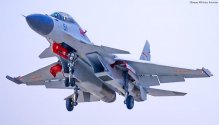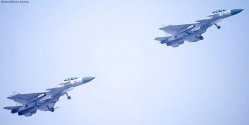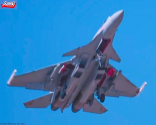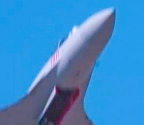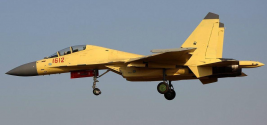Some reflections/thoughts into the air -
(1)
Slightly odd, that J-15S appears(?) to be a J-15A, not -B variation from a technical perspective; odd because it's 2023, not 2013, after all.
We don't really know the kind of radar fitted under the hood(I've already voiced my reservations in the PLAAF thread), but the fact the nose cone itself is of an old type (non-inclined, older-type vertical ESA/dish array cone. Likely, no RCS optimization yet, as this particular part is generally a good indicator of other adaptations). Also, the lack of numerous visible next-gen directional ESA datalinks, is characteristic of both 5th-gen and most recent non-LO airframes: to compare, while j-15b picture sucks is shaky, we can in fact see shapes that we can interpret as such.
On the other hand, J-15S can be considered the first major, entirely local carrier-borne fighter; J-15A is still very much a Sino Su-27k with updated/localized electronics; J-15B is still a prototype. Significant structural and internal changes in J-15S are undeniable (there was no matching Russian naval flanker).
Either way, it's a significant milestone nonetheless (and a successful rob of J-15B/D of the title).
(2)
Tactics&compositions.
Since those are combat planes, there is a lot of space for interpretations.
Will two-seaters form a significant part of units&deck deployments? That only makes sense, if we go by USN and MN examples.
Likely proportions - seem to be around 3:1 or 2:1 of the J-15A fleet, for now - or more? PLAN now goes from essentially one f/w type on the deck to 2 - and, in relatively short order, no less than 5 (manned) - J-15A/B/S/D, J-35. That's w/o combat and potential tanker drones.
Datalink part (only 'normal' ones) makes the LW aspect questionable (not impossible, but the most obvious corresponding optimizations aren't visible) - thus likely explanation are the more mundane ones: advanced training, better surface attack capability, in-flight command&control.
(3)
Coastal/(deck replenishment) units.
PLAN maintains a very sizeable coastal fighter force; for those (inherently multirole) formations, what does J-15S represent? Shall we expect J-11BS replacement(with a unit of arguably ~similar or even lesser - weight! - capability), or something else?

